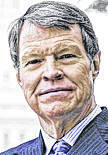
Last March President Donald Trump issued an executive order “promoting energy independence and economic growth.”
While he specifically included “renewable sources,” he clearly intended to unleash the nation’s massive fossil fuel resources, which is the only conceivable way to achieve energy independence — at least for the foreseeable future.
Since the 1970s, when Middle East oil producing countries imposed an oil embargo to punish the U.S. for its support of Israel, U.S. policy has promoted energy independence.
The U.S. had supposedly reached “peak oil” in the early ’70s, where easy-to-reach crude oil had already been extracted; production was expected to decline while prices increased. Thus it seemed that embracing renewable energy sources, especially corn-based ethanol, would be necessary to fill the energy gap.
But American innovation came to the rescue, as it so often does.
Natural gas and crude oil producers developed ways to crack the shale formations that contained untold reserves of oil and gas.
That process, known as “fracking,” along with horizontal drilling, opened up vast new hydrocarbon resources. Today, the U.S. has become the world’s largest producer of crude oil and natural gas.
In 2016, the U.S. produced 14.9 million barrels a day of crude oil, associated liquids, and biofuels, according to the Energy Information Administration (EIA). Saudi Arabia only produced 12.4 million barrels per day and Russia 11.2 million.
In addition, the U.S. produced 27 trillion cubic feet of natural gas in 2015, compared with Russia’s 21.1 trillion. Third-ranked Iran extracts one-quarter of what the U.S. produced.
Even so, the U.S. must still import about 6 million barrels of crude oil per day.
Renewable sources help, but play a minor role. And that’s after eight years of the most pro-renewable energy president we’ve ever had and billions of dollars in subsidies.
Take electricity generation, which is the largest source of energy consumption. According to the EIA, natural gas powers about 34 percent of electricity generation, coal 30 percent and nuclear power 20 percent.
Renewable energy sources provide 15 percent, with about half of that from hydro power.
When people think of “renewables,” they generally think of wind and solar power. Yet wind power only provides 6 percent of total electricity generation, solar 1 percent and biomass — consisting of organic material like wood, plants and corn cobs — only about 2 percent.
That’s barely enough to run one of our major cities, much less the largest economy in the world. And that’s only if the sun is shining and the wind is blowing, which they often aren’t.
The EIA reports, “During the recent cold weather event that affected much of the eastern United States, more natural gas was withdrawn from storage fields around the country than at any other point in history.” Renewables can’t match that.
Even hydro power can be sporadic, as Montana experienced during last summer’s drought.
And then there’s ethanol, which makes up about 10 percent of our gasoline. But car manufacturers have repeatedly warned that increasing that ratio will damage millions of car engines.
The good news is that the U.S. has had a long-running energy-sector relationship with Canada and Mexico, thanks in large part to the 1994 North American Free Trade Agreement, which let energy products and services flow between countries with no tariffs and limited restrictions.
In 2016, the three North American economies produced a total of 22 million barrels of crude oil per day and about 33.7 trillion cubic feet of natural gas in 2015.
Free trade in energy has transformed North America, helping the continent close in on energy independence, while boosting economic growth for all three countries.
Energy independence for the U.S. alone is still years away — and may never arrive if we rely solely on renewables. But thanks to free trade, energy independence for North America is within our grasp.


